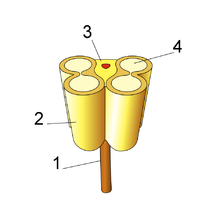Anther
In angiosperm plants, the anther, from the Greek anteros = 'flowered', alluding to the fact that the visible presence of the anthers marks the point peak of the anthesis (flowering), is the terminal part of the stamen of a flower. It is a structure homologous to the microsporangium in other clades and is in charge of pollen production.
Each stamen is usually based on a small foot called the filament and an anther, attached laterally to the end of the filament. Anthers are said to be extrorse if the filament is attached to the anther on its outer face (the one furthest from the floral axis), and they are called introrse in the Otherwise, less frequent.
The typical anther of angiosperms usually consists of two distinguishable, contiguous parts, called theca, joined by an area called the connective, which is also where the anther joins the filament. If the anther is cut perpendicular to its axis, it is observed that each anther contains one or two pollen sacs that extend its entire length.
The anther is a dehiscent structure, that is, it breaks spontaneously to reveal its content, the pollen. Each pollen sac will generally open through a longitudinal dehiscence (cut) through which the pollen will exit.
The stamen is a leaf transformed for the production of male spores (microspores) which are the pollen grains. The pollen sacs are the microsporangia.
Anatomy
In a cross section of a young anther, the following layers are seen from the outside in:
- Epidermis or exotecio, thin and continuous. Sometimes you can break or collapse or interrupt.
- Mechanical fabric or endothetium, fibrous layer on the outer edges of polynic bags. Sometimes it's still in the internship.
- 2 to 4 strata or layers of parenchimatic cells, which soon disappear crushed, or degenerate quickly.
- Tape or nutritious tissue.
- Sporogen or arquorium fabric, constitutes each polynic sack. Sporogen tissue cells form by mitotic divisions the stem cells of pollen or microsporocites, rather large cells, with voluminous nucleus.
Dehiscence
Dehiscence occurs thanks to the endothecium. Its cells present unevenly thickened walls, with broader lignified threads towards the inner face of the cell, where they join each other; instead they taper towards the outer face. For this reason, when the dehydration of the cells occurs, they shorten tangentially, causing tensions that lead to the opening of the anther. Dehiscence is the last function of the anther, which causes the release of pollen grains. This process is exactly coordinated with the differentiation of the pollen, the floral development and its opening.
The wall of the anther is split longitudinally, producing an indentation between the locules of each theca.
The stomium is the region of the anther where dehiscence occurs. Necroptic degeneration of the stomium and septum cells is part of the programmed cycle of cell development and death. Expansion of the endothelial layers and lignification of the endothelial cell walls are essential for dehiscence.
Depending on the shape of the anther opening, it can be classified as:
- Longitudinal dehiscence: When the antere opens longitudinally, that is, from top to bottom, or vice versa.
- Cross-sectional dehiscence: When the antenna opens transversally.
Apical dehiscence: that in which an apical pore opens through which pollen exits.
According to the direction in which the filaments carry out the dehiscence process, it can be:
- Introus dehiscence: The one that happens to the center of the flower, this facilitates self-pollination.
- Exort dehiscence: the one that happens out of the flower, which forces to a large extent the cross politicization.

